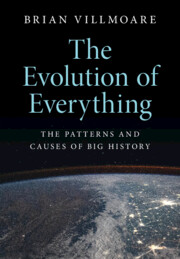Book contents
- The Evolution of Everything
- The Evolution of Everything
- Copyright page
- Contents
- Figure Credits
- Acknowledgments
- Chapter 1: Introduction
- Part I Introduction to the Scientific Perspective on the Past
- Chapter 2: The Origins of the Universe
- Chapter 3: The Structure and History of the Earth
- Chapter 4: Life
- Chapter 5: Evolution
- Chapter 6: Genetics
- Chapter 7: The Evolution of Complex Life
- Chapter 8: The Cambrian Explosion
- Chapter 9: Fish and Land Animals
- Chapter 10: Protohumans
- Chapter 11: The Genus Homo
- Chapter 12: Human Variation
- Chapter 13: Evolution and Human Behavior
- Chapter 14: Brain Evolution
- Chapter 15: Chaos and Complexity
- Part II Science and History
- Additional Readings
- Index
Chapter 11: - The Genus Homo
from Part I - Introduction to the Scientific Perspective on the Past
Published online by Cambridge University Press: 03 November 2022
- The Evolution of Everything
- The Evolution of Everything
- Copyright page
- Contents
- Figure Credits
- Acknowledgments
- Chapter 1: Introduction
- Part I Introduction to the Scientific Perspective on the Past
- Chapter 2: The Origins of the Universe
- Chapter 3: The Structure and History of the Earth
- Chapter 4: Life
- Chapter 5: Evolution
- Chapter 6: Genetics
- Chapter 7: The Evolution of Complex Life
- Chapter 8: The Cambrian Explosion
- Chapter 9: Fish and Land Animals
- Chapter 10: Protohumans
- Chapter 11: The Genus Homo
- Chapter 12: Human Variation
- Chapter 13: Evolution and Human Behavior
- Chapter 14: Brain Evolution
- Chapter 15: Chaos and Complexity
- Part II Science and History
- Additional Readings
- Index
Summary
Our genus is characterized by a unique dependence on technology, which is first seen in the mid-Pleistocene and becomes more sophisticated through time. The trend towards increasing encephalization appears to accelerate once tools have been acquired, coincident with a focus on meat-eating. This chapter reviews later Pleistocene species, including the Neanderthals, with whom we share many behavioral adaptations. However, there appear to be several critical differences, especially in the potential for language and possibly figurative expression, that may have made the difference over millennia, so that by 25,000 years ago we were the only human species left on Earth.
Keywords
- Type
- Chapter
- Information
- The Evolution of EverythingThe Patterns and Causes of Big History, pp. 145 - 158Publisher: Cambridge University PressPrint publication year: 2022

